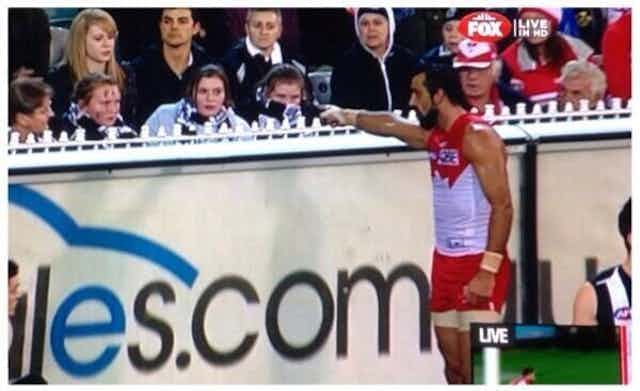The recent controversy around certain football fans incessantly booing Adam Goodes has sparked collective soul-searching as we struggle to distinguish the line between racism and benign on-field antics. Regardless of what we might call it, there are things that you can do when you witness behaviour such as this.
Goodes being booed while playing football is a very public case of “everyday racism”. Everyday racism is more normalised and less recognised than other more blatant forms of racism, such as calling Goodes an “ape” as a 13-year-old girl did during a 2013 game in Melbourne.
Any one of us can do something about such instances, but before we go on, here are some provisos. We’re not saying that everybody who booed Goodes was racist. Nor do we consider whether this incident signals a deep-seated national racism as others have argued.
What we’re concerned about here is the hurt inflicted through everyday racism and what we, as a community, can do about it.
Importance of bystanders
Part of the difficulty in calling out racism – and the strength in doing so – is that many cases of everyday racism appear benign; racist jokes, for instance, are frequently seen as just “having a laugh”.
And when we’re uncertain or unclear about something, we often turn to the reactions of other people to help us make sense of the situation. The reactions of these bystanders help us understand what’s going on and take appropriate action. This is known as social influence.
In the Adam Goodes case, we’re all bystanders: the immediate crowd, the people watching from their homes, the broader community, which has been participating in the discussion about what racism is and isn’t, as well as those who have publicly supported the footballer. And it’s vital that we do something about it because bystander action fulfils multiple important social functions.
It shows people who express marginalising beliefs that their views are not supported and may make them think twice about expressing such beliefs again. It also demonstrates support for victims of racism, potentially alleviating some of the suffering caused by such incidents.
Finally, bystander action performs an important societal function – a cohesive society is built on collaboration between different cultural groups. If one group is antagonistic or racist towards another, disharmony rather than cohesiveness follows. And that isn’t good for anybody.
Taking action
Bystander action can be both interpersonal (one person confronting another) or organised at a mass, collective level. An Eagles supporter confronting another Eagles supporter for booing Goodes is an example of bystander action at the interpersonal level.
And the grassroots solidarity campaign #istandwithAdam, the joint statement by the AFL captains supporting Goodes, as well as the flash mob organised yesterday by the University of Melbourne, are all examples of bystander action organised at the collective level.

The dynamics of emotion and identity are central to understanding these types of acts. Emotional reactions are highly visible and can tell us much about how the people around us are interpreting the situation.
A chortle of laughter or the red face of anger communicates volumes about the position of a bystander witnessing racism. Someone who is uncertain about whether this “is” or “isn’t” racism may think: if everyone is laughing, then how can this possibly be racism, since everyone knows that racism isn’t funny.
We also tend to feel an affiliation towards and identify with people we laugh with – and the people we “boo” with. But displays of solidarity tend to be initiated by a spark of anger.
Anger communicates disapproval of an event, but also suggests that others should also disapprove. Bystanders can use this shared emotional response to respond collectively – and either confront the perpetrators or provide support for the victim.
Depending on the emotional reactions of other bystanders (laughter or anger), an ambiguous set of actions can be dismissed as “just a joke”, “all part of the game”; or as a pervasive and particularly marginalising form of racism. We’re more likely to act when we feel certain our views are legitimate and supported. And our sense of identifying with the victim and other bystanders allows us to unconsciously coordinate an appropriate response.
What to do
Racism isn’t confined to certain sporting codes and people can call it out when they witness it in daily life. Goodes himself set a good example when he confronted a teenage girl for calling him an ape.
But it’s important to first be mindful of your personal safety. Only confront racism if you feel you are safe in doing so. There have been a number of well-publicised incidents where a very aggressive person is abusing another person.
Such aggression may make it difficult to intervene, but you can show your support in other ways. You could offer support for the victim, implicitly and explicitly challenging the perpetrator’s views. Or you could record the encounter on your phone, or report it to the authorities – or both. After all, racial vilification is an offence in Australia.
Remember that any challenge to someone who is being racist is likely to be more productive if it’s done without overt anger. Anger can be misinterpreted as aggression and may provoke hostility, inadvertently producing an unsafe situation.
Since people who endorse racist beliefs are paradoxically more likely to believe that others support their marginalising worldviews, one of the most effective things you can do when confronting someone about racism is to simply disagree. In a similar vein, a racist joke will not seem funny if nobody is laughing.
This case has guided the public spotlight on something experienced by many Indigenous people all too often. As bystanders – on-field and off – we all have a powerful role to play in mitigating the social and personal harm caused by everyday racism.

